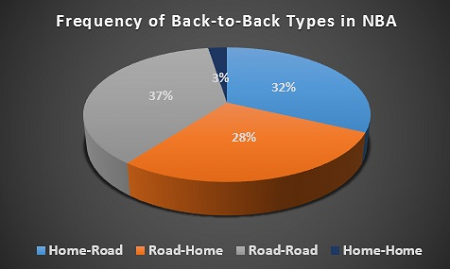NBA Back-to-Backs
There’s a reason NBA teams typically get a day of rest between games; basketball is a physically demanding sport, and players not only need rest during games, but also between them. Further, since teams don’t have series in the same way as MLB, there needs to be a certain amount of time allotted for travel, which also affects performance.
When teams play the second game of a back-to-back set, they’re typically fatigued, whether it be from the games themselves, too much travel, mental exhaustion, or whatever. We’d expect that teams playing back-to-back sets would see a dip in their effectiveness, but how much?
Looking at data from databasebasketball.com, we see that teams win around just 43 percent of their games that are the second in a back-to-back slate. The sample is large enough to control for things like team strength, game location, and travel, so that drop from the overall 50 percent win rate is substantial; in an 82-game season, it’s the difference between 41 wins and just over 35—a dip of 14 percent.
Team wins aren’t 100 percent correlated with fantasy points, but they’re going to be a pretty good proxy; teams win more, obviously, when they score more and allow fewer points. We should be able to garner meaningful fantasy insights from studying back-to-back win rates.
But not all back-to-back games are created equally. Here’s how the NBA has historically split up back-to-backs.

Only three percent—slightly less, actually—of all back-to-back games involve a team that gets to play at home twice in a row. The other combinations are split up fairly evenly, with road-road back-to-backs the most common at 37 percent, followed by home-road (32 percent), and road-home (28 percent). So basically, the NBA is most likely to put a team on road-road back-to-backs—likely just the necessary result of scheduling issues—but highly unlikely to allow them to stay at home two nights in a row.
The nature of the back-to-back affects performance. Below, I charted the win rates for each team in the second game of each type of back-to-back set.

This is pretty strong evidence that certain types of back-to-backs are worse than others; namely, playing on the road in the second game, regardless of where the first game was played, puts teams at a severe disadvantage. They’ve won only 32.9 percent of the time in the second game of a road-road back-to-back and just 37.3 percent during a home-road set.
Meanwhile, teams might be at their best when they come home and play a back-to-back after being on the road—nothing like good ol’ home cookin’. It’s interesting that the win rate in the second game of home-home back-to-backs is just slightly over 50 percent, but that’s likely just due to a small sample; remember, with fewer than three percent of all back-to-backs being of the home-home variety, there’s really not too much to study there.
In daily fantasy, you don’t need to automatically fade a team playing a back-to-back. If a player is sensational value, that’s probably not going to be thrown off too heavily by a back-to-back. I’d pay a little more attention to back-to-backs with the second game on the road, however, using them as a tiebreaker between two players. Another potential strategy might be to target players facing the team on the road in the second game of a back-to-back.
Finally, you might want to consider actually targeting players at home in the second game of a back-to-back, especially in GPPs; the numbers suggest that they’re not really going to see a dip in production, but a lot of users figure to fade them solely because they notice the back-to-back. Thus, you can implement a natural contrarian strategy that is perceived as sub-optimal but, in reality, is probably a really easy way to generate a unique lineup without losing value.